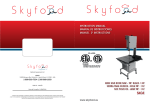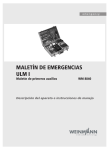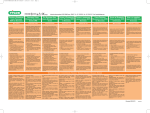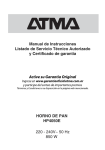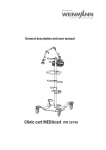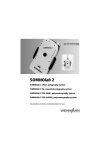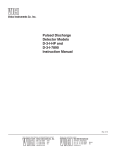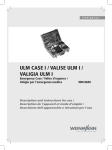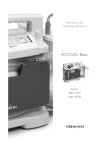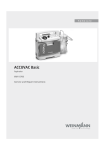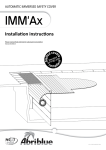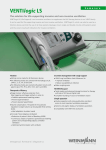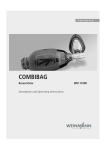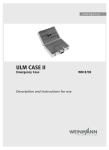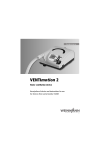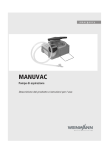Download Instructions for use
Transcript
Module System Oxygen MODULE WM 22200 Suction MODULE WM 22220 Combi MODULE WM 22210 Interface MODULE WM 22230 CPAP MODULE WM 29100 Description and instructions for use Contents 1. Overview . . . . . . . . . . . . . . . . . . . . 3 1.1 Markings on the device . . . . . . . 4 2. Description of device . . . . . . . . . . . . 6 2.1 Intended use . . . . . . . . . . . . . . . 6 2.2 User qualification . . . . . . . . . . . . 6 2.3 Combination options . . . . . . . . . 7 2.4 Storage . . . . . . . . . . . . . . . . . . 7 3. Safety instructions . . . . . . . . . . . . . . 8 3.1 Safety instructions . . . . . . . . . . . . 8 3.2 Contraindications . . . . . . . . . . . 11 3.3 Side effects . . . . . . . . . . . . . . . 12 4. Assembly . . . . . . . . . . . . . . . . . . . 13 4.1 Assembling the modules . . . . . . 13 4.2 Connecting oxygen supply. . . . . 14 4.3 External oxygen connection . . . . 16 4.4 Assembling breathing station . . . 17 4.5 Assembling the bubble humidifier 17 4.6 Assembling the OMNIVAC secretion aspiration system . . . . . 18 4.7 Assembling the CPAP valve . . . . 20 5. Oxygen MODULE . . . . . . . . . . . . . 21 5.1 Inhalation function . . . . . . . . . . 21 5.2 Operation . . . . . . . . . . . . . . . 22 5.3 Stop inhalation . . . . . . . . . . . . 23 6. Suction MODULE . . . . . . . . . . . . . . 24 6.1 Vacuum/aspiration function . . . . 24 6.2 Operation . . . . . . . . . . . . . . . 24 6.3 Stop aspiration . . . . . . . . . . . . 25 7. Combi MODULE . . . . . . . . . . . . . . 26 7.1 Inhalation function . . . . . . . . . . 26 7.2 Vacuum/aspiration function . . . . 27 7.3 Inhalation - operation . . . . . . . . 27 7.4 Stop inhalation . . . . . . . . . . . . 28 7.5 Aspiration - operation . . . . . . . . 29 7.6 Stop aspiration . . . . . . . . . . . . 30 8. Interface MODULE . . . . . . . . . . . . . 31 8.1 Coupling/oxygen connection function . . . . . . . . . . . . . . . . . 31 8.2 Operation . . . . . . . . . . . . . . . 31 9. CPAP MODULE . . . . . . . . . . . . . . .32 2 EN Contents 9.1 CPAP function . . . . . . . . . . . . . 32 9.2 Operation . . . . . . . . . . . . . . . . 32 10. OMNIVAC secretion aspiration system . . . . . . . . . . . . . . . . . . . . .35 10.1 Starting work. . . . . . . . . . . . . . 36 10.2 Aspiration. . . . . . . . . . . . . . . . 36 10.3 Stop aspiration . . . . . . . . . . . . 38 11. Hygiene treatment . . . . . . . . . . . . .39 11.1 Preparing the OMNIVAC secretion aspiration system. . . . . 39 11.2 Cleaning, disinfecting and sterilizing . . . . . . . . . . . . . . . . 40 11.3 Assembling the OMNIVAC secretion aspiration system. . . . . 41 12. Function check . . . . . . . . . . . . . . . .42 12.1 Intervals . . . . . . . . . . . . . . . . . 42 12.2 Check filling . . . . . . . . . . . . . . 43 12.3 Test leaktightness . . . . . . . . . . . 44 12.4 Checking inhalation . . . . . . . . . 45 12.5 Checking aspiration . . . . . . . . . 46 12.6 Checking oxygen flow . . . . . . . 47 12.7 Testing the pressure gauge. . . . . 47 13. Troubleshooting . . . . . . . . . . . . . .48 13.1 Adjusting pressure gauge . . . . . 49 14. Servicing . . . . . . . . . . . . . . . . . . . .50 14.1 Intervals . . . . . . . . . . . . . . . . . 50 14.2 Scope of servicing . . . . . . . . . . 50 14.3 Disposal. . . . . . . . . . . . . . . . . 51 15. Scope of supply . . . . . . . . . . . . . . .52 15.1 Standard scope of supply . . . . . 52 15.2 Accessories. . . . . . . . . . . . . . . 54 15.3 Replacement parts . . . . . . . . . . 56 16. Technical data . . . . . . . . . . . . . . . .57 16.1 Determining oxygen concentration . . . . . . . . . . . . . 58 16.2 External oxygen output . . . . . . . 61 16.3 Oxygen output, inhalation . . . . . 62 16.4 Aspiration performance . . . . . . . 62 17. Warranty . . . . . . . . . . . . . . . . . . .64 18. Declaration of conformity . . . . . . .65 1. Overview 1 2 1 3 2 3 MODUL Oxygen O2 Inhalation MODUL Suction I I Medium Vac 0 0 2,7 - 6 bar O2 8 7 l/min 2,7 - 6 bar O2 8 5 4 2 6 Suction MODULE Oxygen MODULE 1 5 4 l/min 3 1 2 3 MODUL Combi Medium Vac I O2 0 0 2,7 - 6 bar O2 9 I l/min 7 6 5 4 8 Combi MODULE 1 2 8 Interface MODULE Key 3 MODUL CPAP I 2,7 - 6 bar O2 O2 8 10 11 5 CPAP MODULE 4 0 hPa 1 Oxygen inlet with nonreturn valve (not seen) 2 Display 3 Oxygen outlet 4 Toggle switch 5 Regulator dial 6 Vacuum connection 7 Inhalation connection 8 External oxygen connection 9 Vacuum on/off switch 10 Pressure measurement tube connection 11 CPAP valve connection Overview EN 3 1.1 Markings on the device O2 2 3 8 1 4 5 8 6 78 ID plate for MODULES SN Serial number of device Date of manufacture Type of gas: O2 CE symbol (confirms that the product conforms to the applicable European directives) 1 : Permitted inlet pressure 2.7 - 6 bar O2 Follow instructions for use Other markings 4 2 Inhalation connection 3 Aspiration connection EN Overview 4 O2 Oxygen inlet and outlet 2,7-6 bar 5 6 Oxygen outlet O2 CPAP O2 outlet for CPAP 7 Permitted inlet pressure 2.7 - 6 bar O2 8 Service label: indicates when the next service is required. Overview EN 5 2. Description of device 2.1 Intended use Oxygen Suction Combi Interface CPAP MODULE MODULE MODULE MODULE MODULE Intended use To increase the percentage proportion by volume of oxygen in inhaled air X – X – X To create a vacuum to enable relatively large accumulations of blood, mucus, saliva etc. as well as viscous and solid pieces of food to be extracted from the oral cavity, the pharyngonasal cavity and the bronchial system with the aid of a secretion aspiration system – X X – – To pass the oxygen supply on to other devices via the coupling connection X X X X X To facilitate an external oxygen supply via the coupling connection X X X X X To supply the CPAP valve (Boussignac CPAP valve for CPAP MODULE) via a regulatable oxygen flow rate to achieve and display a desired therapy pressure – – – – X 2.2 User qualification The modules may only be used and operated by people with the following qualifications: 6 EN • medical training and instruction in non-invasive ventilation technology. • instruction in how the modules work. Description of device 2.3 Combination options You can use modules individually or connected in series of up to three modules. Another option is to connect up to three modules to the MEDUMAT ventilation device. Always operate only one module or one Medumat at a time. If you use modules simultaneously, it is possible the supply of O2 will be inadequate. 2.4 Storage If a module is not used for an extended period, we recommend the following procedure. 1. Perform a hygiene treatment (see “11. Hygiene treatment” on page 39). 2. Store the module in dry conditions. Description of device EN 7 3. Safety instructions 3.1 Safety instructions For your own safety and that of your patients, and in accordance with the requirements of directive 93/ 42/EEC, observe the points below. General 8 EN Safety instructions • Please read these instructions for use through carefully. They are a constituent part of the device and must be available at all times. • Read carefully through the instructions for use for the accessories used. They form part of the accessories. • Before you work with the modules, you must have understood how to operate them. • Follow the section entitled “11. Hygiene treatment” on page 39 to prevent an infection or bacterial contamination. • Do not use the modules in a toxic or dusty atmosphere. • Use the modules only in the permitted ambient conditions (see “16. Technical data” on page 57). • Use only the accessories mentioned in Section 15. • Use the modules only for the intended purpose described (see “2.1 Intended use” on page 6). • You may never operate more than one device simultaneously, otherwise it is impossible to guarantee compliance with the specified technical data. For the same reason, you may not operate the modules whilst oxygen is being tapped off for external devices. • The modules are not suitable for hyperbaric (pressure chamber) use. • Please monitor that the devices are functioning perfectly during use, as well – especially if cylinder pressure is dropping. • In the event of a device failing, you need to have an alternative to hand, e.g. for aspiration, the MANUVAC manual aspiration pump in case the Suction MODULE or Combi MODULE breaks down. Accessories/repairs • Have repair work performed only by the manufacturer, Weinmann, or authorized staff. • If third-party items are used, functional failures and restricted fitness for use may result. Biocompatibility requirements may also not be met. You should be aware that in these cases, any claim under warranty or liability will be void if neither the accessories recommended in the instructions for use nor genuine replacement parts are used. • Protect rubber parts from UV light and prolonged exposure to sunlight, otherwise they may become brittle and friable. Oxygen In combination with flammable substances (grease, oil, alcohol etc.), highly-compressed oxygen can lead to spontaneous explosive reactions. • Keep the devices and all screwed connections absolutely free of oil and grease. Safety instructions EN 9 Important • It is essential to wash your hands before working on the oxygen supply. • Smoking and naked flames are strictly prohibited in the vicinity of fittings which carry oxygen. • During assembly and when changing cylinders, tighten all screwed connections on the oxygen supply and on the pressure reducer only by hand. Under no circumstances may you use tools. Excessive tightening damages the threads and seals and then leads to leaks. • Secure oxygen cylinders so they cannot tip over. If the cylinder falls on the pressure reducer or the valve, these could be torn off, triggering a violent explosion. • Ensure that the respiratory gas is adequately temperature-controlled. Excessively warm or cold gas may harm the patient. Please also observe the permitted ambient conditions (see “16. Technical data” on page 57). • Always open the cylinder valve slowly to prevent hammering on the fittings. • Do not empty cylinders completely, otherwise damp ambient air may penetrate and lead to corrosion. Inhalation • If you use Weinmann inhalation masks, a dangerous rise in pressure is not possible. • However, please ensure that the exhaled respiratory gas can flow away freely. Aspiration • 10 EN Safety instructions Use the Suction MODULE and the Combi MODULE only if you are medically trained and familiar with aspiration technology. Severe physical injuries can be caused by incorrect use. Important! • Pay particular attention during aspiration to ensure that no injuries are caused to the patient’s oropharyngeal cavities, e.g. to the mucous membranes. • For bronchial aspiration, work under sterile conditions and use only sterile aspiration catheters. • Dispose of fluids such as blood and secretions, as well as parts contaminated with these fluids, as per the guidelines in the Federal Health Gazette entitled “Anforderungen der Hygiene an die Abfallentsorgung” [Hygiene requirements when disposing of waste] (published by the Federal Office of Health and obtainable from Carl Heymanns Verlag, Cologne). • Please ensure that the aspirate bottles are always upright during aspiration, otherwise the ball of the overflow cutout cannot reliably block the outlet. CPAP therapy • The CPAP MODULE is not licensed for inhalation. • Use the CPAP MODULE only if you are medically trained and familiar with CPAP therapy. Severe physical injuries can be caused by incorrect use. 3.2 Contraindications Observe the contraindications for the therapies in question. These may include (examples): • impaired consciousness • lung diseases requiring intubation • use of mask impossible • undrained pneumothorax • intracranial hypertension. Safety instructions EN 11 3.3 Side effects If the contraindications are taken into account, no side effects are likely in use with normal oxygen. However, observe the side effects mentioned in the patient information leaflet entitled “Medical oxygen” in the case of 12 EN Safety instructions • newborns • administration of 100 % oxygen • administration of oxygen under elevated pressure. 4. Assembly If the modules are supplied complete on a LIFE-BASE or LIFE-BASE Mini carrying platform, they are operational and you need not perform any further assembly. 4.1 Assembling the modules Connecting 1. Release the connection to the oxygen supply (see “Removing an empty cylinder” on Page 15). 2. Unscrew the cover of the oxygen outlet from the module. If you screw the cover back on later, tighten it just hand-tight to prevent damage to the housing. 3. Push the protective ring supplied over oxygen outlet 3. The protective ring prevents dirt penetrating the housing. O–ring Protective ring 4. Plug the modules together. The seal is made by the O-ring. Assembly EN 13 5. Connect any other modules in exactly the same way. No more than 3 modules may be connected, otherwise it is impossible to guarantee compliance with the specified technical data. 6. Screw the modules and, if appropriate, the MEDUMAT onto the assembly plate from the back as shown in the assembly instructions provided, or screw the modules to a solid wall from the back. Please note that screws should protrude no more than 5.5 mm into the modules. 4.2 Connecting oxygen supply Wash your hands thoroughly before any work on the oxygen supply. Hydrocarbon compounds (e.g. oil, greases, alcohols for cleaning, hand cream or sticking plaster) can lead to explosive reactions if they come into contact with highly-compressed oxygen. Under no circumstances use spanners or other tools to tighten up the union nuts. 14 EN Assembly You should always connect the oxygen supply at the extreme left-hand module, as oxygen inlet 1 of all modules is equipped with a nonreturn valve. Inlet with nonreturn valve The nonreturn valve ensures that the oxygen can get in but cannot get out at this connection. Oxygen outlet 3 has no non-return valve. Outlet without nonreturn valve For the same reason, the MODULE which allows connection to an additional external oxygen supply (in this case an Interface MODULE) should always be attached the furthest to the left. Removing an empty cylinder 1. Close the valve on the oxygen cylinder. 2. Switch on a module. This allows any residual oxygen to escape and the device is depressurized. The screwed connection may not be undone until the pressure gauge on the pressure reducer is displaying “0”. 3. Switch the module off again. 4. Undo the manual screwed connection to the cylinder. Connecting a new cylinder 1. Briefly open the valve on the new oxygen cylinder and close it again. This is intended to blow away any particles of dust. Point the valve opening away from your body as you do this so that you injure neither yourself nor any other person with any particles which may fly out! Assembly EN 15 2. Screw the pressure reducer with the corrugated union nut to the cylinder valve. Tighten the union nut hand-tight. 3. Screw the pressure tube with the G 3/8 union nut to the pressure reducer outlet. 4. Screw the other end of the pressure tube to oxygen inlet 1 of the module. 4.3 External oxygen connection In addition to oxygen inlet 1, you can use external oxygen connection 8 to tap off or feed in oxygen. Tapping off oxygen You may not operate a module at the same time as tapping off oxygen, otherwise the specified technical data will not be maintained. Feeding in oxygen You can use the external oxygen feed for example to allow continued working with the modules when the oxygen cylinder is being changed. Due to the nonreturn valves in oxygen inlet 1, oxygen should always be fed in at the module fitted on the extreme left. 16 EN Assembly 4.4 Assembling breathing station Disposable inhalation mask and nasal cannula The disposable nasal cannula and inhalation masks with or without economy bag are made of transparent plastic. For hygiene reasons, they may only be used for one patient. 1. If necessary, screw union nut 7 supplied onto the corresponding threaded connection of the Oxygen MODULE or the Combi MODULE. 2. When the module is used, plug the tube onto the union nut. 4.5 Assembling the bubble humidifier 1. Unscrew the tank from the top part of the bubble humidifier. Assembly EN 17 2. Screw the top part of the bubble humidifier onto the corresponding threaded connection of the Oxygen MODULE or the Combi MODULE by hand. 3. Fill the bottom part up to the mark with distilled water (aqua dest.) and screw the tank back on. 4. Push the tube for the breathing station onto the outlet stub of the bubble humidifier. 4.6 Assembling the OMNIVAC secretion aspiration system The OMNIVAC secretion aspiration system is required for aspiration using the Suction MODULE or the Combi MODULE. 1. Screw the holder for the secretion aspirate bottles to a suitable point. 18 EN Assembly 2. Put both aspirate bottles in the holder. 3. Connect the bottles and the module with the appropriate tubes. Ensure that the bottle with the overflow cutout is connected to the module first. We recommend fitting a hydrophobic bacteria filter WM 22291 for the exhaust air to prevent secretion and bacteria penetrating the module. Filter WM 22291 is obtainable as an accessory, individually or in sets. It is a disposable item and must be replaced after every aspiration operation. 4. Take the vacuum tube off the module. 5. Cut a piece about 6 cm long off the vacuum tube. 6. Put this short piece of tube onto the side of the filter marked with “TO PUMP”. 7. Plug the other end of the short piece of tube onto the vacuum connection of the module. 8. Put the free end of the vacuum tube on the filter. Assembly EN 19 4.7 Assembling the CPAP valve 1. Connect the CPAP valve to the CPAP module using the connecting tubes. Ensure that the tubes are guided cleanly so that they do not impede one another. 2. Perform a function check (see “12.6 Checking oxygen flow” on page 47). O2 Pressure measurement tube 20 EN Oxygen outlet Assembly 5. Oxygen MODULE 5.1 Inhalation function You can perform oxygen inhalation using the Oxygen MODULE. Conditions of use Oxygen inhalation only makes sense in emergency patients who are still breathing spontaneously. This is the case with breathing disorders, for example. In the event of respiratory failure, inhalation of oxygen is by no means adequate and artificial ventilation will be required here. The pressure of the oxygen during inhalation is not adequate to overcome the resistance of the respiratory tract, so not enough oxygen reaches the lungs. The patient is supplied with oxygen via an inhalation mask or nasal cannula. You can also connect the inhalation tube to a ventilation bag to allow ventilation at an increased oxygen concentration. To prevent mucous membranes drying out in the case of prolonged oxygen inhalation, you can fit a bubble humidifier (see “4.5 Assembling the bubble humidifier” on page 17). Oxygen MODULE EN 21 5.2 Operation Oxygen supply 1. Open the oxygen supply valve slowly. The contents pressure gauge now shows cylinder pressure. 2. Calculate remaining operating time, if appropriate (see “Calculating filling level” on Page 43). Method MODUL Oxygen 1. Switch on oxygen inhalation at toggle switch 4. 2. Regulate the quantity of oxygen coming out infinitely between 0 and 15 l/min using dial 5. This corresponds to three revolutions of the dial. The value set is displayed on pressure gauge 2. O2 Inhalation I Determine oxygen concentration if necessary (see “16.1 Determining oxygen concentration” on page 58). 0 2,7 - 6 bar O2 l/min 3. The device is operational when oxygen can be felt coming out at the inhalation mask. 4. Put the inhalation mask or nasal cannula on the patient. Attach these in position using the head band or ear-hooks. 22 EN Oxygen MODULE 5.3 Stop inhalation 1. Check the oxygen reserve at the contents pressure gauge of the pressure reducer. 2. Close the oxygen supply valve and wait until the system is depressurized. 3. Turn dial 5 to the left-hand stop (to “zero”). This prevents the pressure gauge being damaged by hammering when the device is switched back on. 4. Switch the module off using toggle switch 4. 5. Clean and disinfect/sterilize the device and the device parts (see “11. Hygiene treatment” on page 39). 6. Perform a function check (see “12. Function check” on page 42). Oxygen MODULE EN 23 6. Suction MODULE 6.1 Vacuum/aspiration function The Suction MODULE is used to aspirate accumulations of blood, secretions or pieces of food from the oral cavity, nasopharyngeal cavity and the bronchial system. The OMNIVAC secretion aspiration system is available as an accessory, complete with tubes and two aspirate bottles (see “10. OMNIVAC secretion aspiration system” on page 35). 6.2 Operation Oxygen supply 1. Open the oxygen supply valve slowly. The contents pressure gauge now shows cylinder pressure. If appropriate, calculate remaining operating time as a function of cylinder pressure (see “Calculating filling level” on Page 43). 24 EN Suction MODULE Method MODUL Suction I Medium Vac 2. Close the fingertip regulator and hold the opening of the end-piece closed so that no more air can flow through it. 3. Regulate the vacuum using dial 5. There are three revolutions of the dial between minimum and maximum. 4. Check the value set at pressure gauge 2. 0 2,7 - 6 bar O2 1. Switch on the vacuum at toggle switch 4. l/min 5. Now you can aspirate. Keep checking the filling level of the oxygen cylinder from time to time. 6.3 Stop aspiration 1. Check the oxygen reserve at the contents pressure gauge of the pressure reducer. 2. Close the oxygen supply valve and wait until the system is depressurized. 3. Turn dial 5 to the left-hand stop (to “zero”). This prevents the pressure gauge being damaged by hammering when the device is switched back on. 4. Switch the module off using toggle switch 4. 5. Clean and disinfect/sterilize the device and the device parts (see “11. Hygiene treatment” on page 39). 6. Then perform a function check (see “12. Function check” on page 42). Suction MODULE EN 25 7. Combi MODULE You can use the Combi MODULE to perform oxygen inhalation or aspiration. Oxygen inhalation and aspiration may not be used simultaneously, otherwise oxygen output is reduced during inhalation. 7.1 Inhalation function Conditions of use Oxygen inhalation only makes sense in emergency patients who are still breathing spontaneously. This is the case with breathing disorders, for example. In the event of respiratory failure, inhalation of oxygen is by no means adequate and artificial ventilation will be required here. The pressure of the oxygen during inhalation is not adequate to overcome the resistance of the respiratory tract, so not enough oxygen reaches the lungs. The patient is supplied with oxygen via an inhalation mask or nasal cannula. You can also connect the inhalation tube to a ventilation bag to allow ventilation at an increased oxygen concentration. To prevent mucous membranes drying out in the case of prolonged oxygen inhalation, you can fit a bubble humidifier (see “4.5 Assembling the bubble humidifier” on page 17). 26 EN Combi MODULE 7.2 Vacuum/aspiration function The Combi MODULE can also be used to aspirate accumulations of blood, secretions or bits of food from the oral cavity, the nasopharyngeal cavity and the bronchial system. The OMNIVAC secretion aspiration system, complete with tubes, is available as an accessory. There is an example in the adjacent picture. 7.3 Inhalation - operation Oxygen supply 1. Open the oxygen supply valve slowly. The contents pressure gauge now shows cylinder pressure. 2. Calculate remaining operating time, if appropriate (see “Calculating filling level” on Page 43). Combi MODULE EN 27 Method MODUL Combi 1. Switch on oxygen inhalation at toggle switch 4. 2. Regulate the quantity of oxygen coming out infinitely between 0 and 15 l/min using dial 5. This corresponds to three revolutions of the dial. The value set is displayed on pressure gauge 2. Medium Vac I O2 0 I Determine oxygen concentration if necessary (see “16.1 Determining oxygen concentration” on page 58). 0 2,7 - 6 bar O2 l/min 3. The device is operational when oxygen can be felt coming out at the inhalation mask. 4. Put the inhalation mask or nasal cannula on the patient. Attach these in position using the head band or ear-hooks. 7.4 Stop inhalation 1. Check the oxygen reserve at the contents pressure gauge of the pressure reducer. 2. Close the oxygen supply valve and wait until the system is depressurized. 3. Turn dial 5 to the left-hand stop (to “zero”). This prevents the pressure gauge being damaged by hammering when the device is switched back on. 4. Switch off the module by setting toggle switch 4 to “0”. 28 EN Combi MODULE 5. Clean and disinfect/sterilize the device and the device parts (see “11. Hygiene treatment” on page 39). 6. Perform a function check (see “12. Function check” on page 42). 7.5 Aspiration - operation Oxygen supply 1. Open the oxygen supply valve slowly. The contents pressure gauge now shows cylinder pressure. 2. Calculate remaining operating time, if appropriate (see “Calculating filling level” on Page 43). Method MODUL Combi 1. Switch on the vacuum at toggle switch 9. Maximum vacuum is permanently set to –0.5 bar and cannot be read off directly on the pressure gauge. 2. Now you can aspirate. Medium Vac I O2 0 2,7 - 6 bar O2 I Keep checking the filling level of the oxygen cylinder from time to time. 0 l/min Combi MODULE EN 29 7.6 Stop aspiration 1. Check the oxygen reserve at the contents pressure gauge of the pressure reducer. 2. Close the oxygen supply valve and wait until the system is depressurized. 3. Turn dial 5 to the left-hand stop (to “zero”). This prevents the pressure gauge being damaged by hammering when the device is switched back on. 4. Switch the module off using toggle switch 9. 5. Clean and disinfect/sterilize the device and the device parts (see “11. Hygiene treatment” on page 39). 6. Then perform a function check (see “12. Function check” on page 42). 30 EN Combi MODULE 8. Interface MODULE 8.1 Coupling/oxygen connection function The Interface MODULE allows oxygen (2.7 – 6 bar) to be tapped off or additional oxygen to be fed in from an external supply. The Interface MODULE serves as an interface - to the central oxygen supply, for example. You can order it with different quick-fit couplings depending on your requirements. The Interface MODULE has a pressure gauge of 0 10 bar to enable oxygen pressure to be monitored. 8.2 Operation Making the connection To tap off or feed in oxygen, plug the connector into external oxygen connector 8. Push the connector far enough in for it to latch automatically. Releasing the connection To release the connector again, push the release collar towards the module. Release collar Please note that this disconnection must be carried out directly at oxygen connection 8. Interface MODULE EN 31 9. CPAP MODULE 9.1 CPAP function You can use the CPAP MODULE to perform CPAP therapy in conjunction with a CPAP valve approved by Weinmann. Conditions of use Therapy may only be carried out on emergency patients who are breathing spontaneously. In the event of respiratory failure, CPAP therapy is by no means adequate and artificial ventilation will be required here. The patient is supplied with oxygen via a CPAP valve and a breathing mask. Risk to patient! Ensure that the free end of the CPAP valve is not covered or sealed off. The patient must be able to breathe freely. 9.2 Operation CPAP therapy 1. Slowly open the oxygen supply valve. The contents pressure gauge indicates cylinder pressure. 32 EN CPAP MODULE 2. Calculate remaining operating time (see “Calculating filling level” on page 43). Method MODUL CPAP 1. Switch on the oxygen supply to the CPAP valve by switching toggle switch 4 to I. 2. If oxygen escapes from the O2 outlet, switch it off by turning dial 5 to the left until you feel it reach the stop. 3. Connect the CPAP valve to the CPAP MODULE (see “4.7 Assembling the CPAP valve” on page 20). I 2,7 - 6 bar O2 0 hPa 4. Connect the CPAP valve to the breathing mask. 5. Put the breathing mask on the patient. 6. If the patient tolerates the breathing mask, attach it in position using the head band. 7. Increase CPAP pressure to a pressure of approx. 2 mbar by turning the regulator dial to the right. 8. Check that the breathing mask is properly located so it does not leak. Correct the position of the breathing mask if necessary. 9. Increase or reduce the flow of oxygen using the regulator dial until the desired CPAP therapy pressure is reached. To increase therapy acceptance, increase pressure slowly (approx. 1 mbar/ 30 seconds). 10. Check the position of the breathing mask again for leaks or for excessive pressure on the patient’s face. Correct the position of the breathing mask if necessary. 11. Monitor the patient’s therapy with the aid of the displays (CPAP MODULE and gas cylinder pressure gauges). CPAP MODULE EN 33 Stop CPAP therapy 1. Check the oxygen reserve at the contents pressure gauge of the pressure reducer. 2. Close the oxygen supply valve and wait until the system is depressurized. 3. Turn dial 5 anti-clockwise until you feel it reach the stop. This will prevent the next patient inadvertently obtaining too high a CPAP pressure. 4. Switch off the CPAP MODULE using toggle switch 4. 5. Take the breathing mask off the patient. 6. Clean and disinfect/sterilize the device and the device parts (see “11. Hygiene treatment” on page 39). 7. Perform a function check (see “12. Function check” on page 42). 34 EN CPAP MODULE 10. OMNIVAC secretion aspiration system The OMNIVAC secretion aspiration system consists of one or two aspirate bottles and the necessary tubing. The aspirate bottles are available in capacities of 250 ml, 500 ml or 1000 ml. An overflow cutout in the lid of the bottle stops secretion penetrating the module by a ball floating on the surface of the secretion and blocking the outlet. A tube which is connected to the tube stub of the aspirate bottle lid is provided for connection to the vacuum source. We recommend fitting hydrophobic bacteria filter WM 22291 for the exhaust air to prevent secretion and bacteria penetrating the module. The filter is available as an accessory. It is a disposable item and must be replaced after every aspiration operation. A large-lumen aspirating tube with a diameter of 10 mm and a tapered connection is connected for aspirating. This also functions as an aspiration intensifier, allowing even viscous and solid pieces of food to be removed quickly and easily from the mouth and throat. You are thus able to deal effectively with aspiration. You can extend the large-lumen tube with an aspirating tube with a diameter of 6 mm to adapt aspiration catheters. This enables you to remove mucous and blood by the conventional method using aspirating catheters. OMNIVAC secretion aspiration system EN 35 10.1 Starting work Tip Fingertip regulator Catheter Cleaning will be facilitated if you pour about 50 ml of disinfectant or water into the aspirate bottle before you start. The aspirated matter is then less likely to adhere to the bottom of the bottle. 1. If necessary, adapt the end-piece of an aspirating catheter of a suitable size for tracheal or nasopharyngeal aspiration. Aspirating tube End-piece Important! For effective aspiration of viscous and solid pieces of food from the oral cavity, take the end-piece off the aspirating tube and use the aspirating tube on its own. 2. Switch on the vacuum source, e.g. the Suction MODULE, and set the desired vacuum if required. 10.2 Aspiration Pay attention during the aspiration process to ensure that no injuries are caused to the patient’s oropharyngeal cavities, especially to the mucous membranes. • You can briefly interrupt suction, for example if the skin is aspirated, by opening the fingertip regulator. You can leave the fingertip regulator permanently open and hold it closed with a thumb. You then only need to lift your thumb briefly for venting. 36 EN OMNIVAC secretion aspiration system Important! Please ensure that the aspirate bottles are always upright during operation, otherwise the ball of the overflow cutout cannot reliably block the connection to the vacuum source. This could result in secretion getting into the vacuum source. For hygiene reasons, we therefore recommend using hydrophobic bacteria filter WM 22291. If the overflow cutout responds during the aspiration process before the full limit is reached, proceed as follows. 1. Briefly interrupt the aspiration process. 2. Switch off the vacuum source. 3. Keep the aspirate bottle upright (with its lid uppermost) and wait until the ball drops back down. 4. Continue with aspiration. The aspirate bottle can be removed from the bracket to allow aspiration to be performed using the largelumen tube. Note Keep an eye on the fill level of the aspirate bottle during aspiration. Always empty the aspirate bottle as soon as the fill limit is reached. This will prevent the overflow cutout becoming contaminated and minimize cleaning effort. The secretion is aspirated into the front aspirate bottle first. When this aspirate bottle is full, it overflows into the second one. Once this bottle is full too, the overflow cutout stops aspiration continuing. OMNIVAC secretion aspiration system EN 37 Emptying the aspirate bottle When the aspirate bottle is full to the limit, you must interrupt the aspiration process and empty the aspirate bottle. Important! When taking off and emptying the aspirate bottle, please ensure that the lid does not accidentally come off the bottle and cause the contents to spill. 1. Take off the vacuum tube. 2. Take the aspirate bottle out of the bracket. 3. Carefully take off the lid of the aspirate bottle. Important! 4. Empty the aspirate bottle. Comply with the relevant regulations on disposal (see “3.1 Safety instructions” on page 8). 5. Push the aspirate bottle lid back on. 6. Put the aspirate bottle back into the bracket. 7. Reconnect the vacuum tube. 8. You can now continue aspirating. 10.3 Stop aspiration When the aspiration process is complete, proceed as follows. 1. Switch off the vacuum source. 2. Empty the aspirate bottle (see “Emptying the aspirate bottle” on page 38). 3. Clean the OMNIVAC (see “11. Hygiene treatment” on page 39). 38 EN OMNIVAC secretion aspiration system 11. Hygiene treatment The modules and the accessories used must be subjected to a hygiene treatment after every use. After that, you should always perform a function check (see “12. Function check” on page 42). 11.1 Preparing the OMNIVAC secretion aspiration system Note When taking off and emptying aspirate bottles, please ensure that the lid does not accidentally come off an aspirate bottle and cause the contents to spill. 1. Take the tubes off the aspirate bottles and the module. 2. Take the aspirate bottles out of the holder. 3. Take off the aspirate bottle lid. 4. Empty the aspirate bottles. Comply with the relevant regulations on disposal (see “3.1 Safety instructions” on page 8). 5. Remove the connectors and the ball from the overflow cutout in the aspirate bottle lids. Hygiene treatment EN 39 11.2 Cleaning, disinfecting and sterilizing The individual parts can be cleaned, disinfected and sterilized as listed in the table below. Follow the instructions for use for the disinfectant used. We recommend TERRALIN. It is recommended that suitable gloves (e.g. household or disposable gloves) are used for disinfecting. Parts Modules Disinfect Wipe down with a damp cloth Disinfect by wiping Clean cloth, possibly moistened with clean water Oxygen fittings OMNIVAC secretion aspiration system Clean Washing machine cycle Sterilize Not permitted Not permitted Lid of aspirate bottles Ball of overflow cutout Connectors Aspirate bottles Not permitted In hot water with a mild household detergent Immerse in dilute solution (1) Hot-steam Washing cycle sterilization up up to 95 °C to 134 °C (2) Aspirating tube Intermediate tube Vacuum tube End-piece with fingertip regulator Bacteria filter Disposable items, re-use not permitted, replace for every patient Cannula/mask for inhalation, disposable Mask for inhalation, reusable CPAP valve In hot water with a mild household detergent Immerse in dilute solution (1) Hot-steam Washing cycle sterilization up up to 95 °C to 134 °C (2) Disposable item, re-use not permitted, replace for every patient (1) After disinfecting the parts, rinse them thoroughly in distilled water and then leave them to dry. 40 EN Hygiene treatment (2) Hot steam sterilization at 134 °C in devices to EN 285, dwell time 5 minutes. 11.3 Assembling the OMNIVAC secretion aspiration system Following the hygiene treatment, reassemble the parts in reverse sequence (see “11.1 Preparing the OMNIVAC secretion aspiration system” on page 39). Hygiene treatment EN 41 12. Function check If you find any faults or deviations from specified values during the function check, you may not use the modules or OMNIVAC again until the faults have been remedied. We recommend that you always keep in stock: • • seal for tube connection and for inhalation connection WM 1145/31 seal for plug connection WM 1145/68 12.1 Intervals To ensure that you always have modules in perfect working order available, you should observe the following intervals. Before every use • Perform a function check (see following sections). After every use • Clean and disinfect/sterilize the device and the device parts (see “11. Hygiene treatment” on page 39). • Perform a function check (see following sections). At least every 6 months, if not used in between • 42 EN Function check Perform a function check (see following sections). 12.2 Check filling Open the oxygen supply valve slowly. You can now read off cylinder pressure at the pressure gauge of the pressure reducer. A display of 200 bar, for example, means that the cylinder is full, whilst at 100 bar, it is still half full. You should ensure that you have a refill or reserve cylinder ready to guarantee the operational readiness of the device – for example, if the pressure gauge displays 50 bar or less. Calculating filling level Oxygen volume = cylinder volume x cylinder pressure. Cylinder volume x cylinder pressure = oxygen reserve Example 1 10 l x 200 bar = 2000 l Example 2 2l x 100 bar = 200 l Calculating operating time for oxygen inhalation Example: O2 reserve = 1000 l; setting for O2 inhalation 6 l/ min: Operating time for inhalation (min) = 1000 l 6 l/min = 166 min = 2 h 46 min Calculating operating time for aspiration Example: O2 reserve = 1000 l; consumption for aspiration 17 l/min (max.): Operating time for aspiration (min) = 1000 l 17 l/min = 58 min Function check EN 43 Calculating operating time for CPAP therapy Example: O2 reserve = 1000 l; setting for CPAP 5 hPa = O2consumption of 20 l/min: Operating time for CPAP therapy (min) = 1000 l = 50 min 20 l/min Set CPAP therapy pressure [hPa] Consumption with Boussignac CPAP valve for CPAP MODULE [l/min] 1 approx. 7,5 2 approx. 12 3 approx. 15 4 approx. 17.5 5 approx. 20 6 approx. 22.5 7 approx. 25 8 approx. 27.5 9 approx. 30 10 approx. 32.5 12.3 Test leaktightness Important for CPAP MODULE! Never seal the CPAP valve completely during operation. This may damage the pressure gauge. 1. Close the oxygen supply valve. 2. Switch on a module. This allows any residual oxygen to escape and depressurizes the system. 3. Switch the module off again. 44 EN Function check 4. Check that all screwed connections and tube connections are secure. Tighten up screwed connections by hand if necessary. Under no circumstances may you tighten up the screwed connections with a spanner or other tools. 5. Open the oxygen supply valve slowly. 6. Close the valve again. 7. Watch the needle of the pressure gauge on the pressure reducer for approx. 1 minute. If the needle position remains constant, the system is leaktight. If the needle keeps dropping, there is a leak. Eliminating a leak We recommend keeping replacement seals for the connections in stock. 1. Prepare a solution of soap and water using unperfumed soap. 2. Use this solution to wet all connections, whether screwed, tube or plug connections. Bubbles will now form at the site of any leak. 3. Depressurize the system (shut off the oxygen supply, briefly switch on the module then switch it off again). 4. Replace the damaged sealing rings. 5. Then check for leaks again. 12.4 Checking inhalation Required for Oxygen MODULE and Combi MODULE 1. Connect the inhalation mask to the threaded connection for inhalation. 2. Open the oxygen supply valve slowly. 3. Switch on the module. 4. Use the dial to set oxygen output to 6 l/min. Function check EN 45 5. The oxygen must be felt to come out at the breathing station. 6. Switch off inhalation immediately afterwards to save oxygen. 12.5 Checking aspiration Required for Suction MODULE and Combi MODULE 1. Open the oxygen supply valve slowly. 2. Switch on aspiration. 3. Suction MODULE: turn the dial to the right-hand stop. Take off the vacuum tube and hold vacuum connection 6 closed. Combi MODULE: the vacuum is permanently set to ≥ – 0.5 bar (at 4.5 bar O2 inlet pressure) and cannot be read off directly on the pressure gauge. You should therefore plug Weinmann test pressure gauge WM 15294 onto connection for the vacuum 6. 4. Read off the value which becomes constant on the pressure gauge (Suction MODULE) or on the test pressure gauge (Combi MODULE). This value must be at least – 0.5 bar at a feed pressure of 4.5 bar. 5. Suction MODULE: to check that the OMNIVAC secretion aspiration system is leaktight, connect the vacuum tube again and hold the aspiration opening of the end-piece closed instead. Combi MODULE: to check that the OMNIVAC secretion aspiration system is leaktight, connect Weinmann test pressure gauge WM 15294 to the end-piece of the fingertip regulator. Hold the fingertip regulator closed as you do so. 6. After no more than 30 seconds, at least – 0.5 bar must be displayed. If this value is not reached, the connections must be checked for leaks. 46 EN Function check 12.6 Checking oxygen flow Required for the CPAP MODULE 1. Switch on the MODULE. 2. Use the dial to open the oxygen supply. The oxygen must be felt to come out at the CPAP valve connection. 3. Switch off the oxygen supply immediately afterwards to save oxygen. 12.7 Testing the pressure gauge Required for the CPAP MODULE 1. Plug the test set (WM 15665) onto pressure measurement tube connection 10. 2. Crush the test set. Pressure on the pressure gauge must rise. O2 3. Kink the test set in the centre and hold in this position for about 5 seconds. Pressure may not drop continuously during this time. O2 Function check EN 47 13. Troubleshooting Fault Cause of fault Unusually high oxygen consumption Remedy Leak in system Find and eliminate leak (see “12.3 Test leaktightness” on page 44) Oxygen cylinder empty Replace oxygen cylinder (see “4.2 Connecting oxygen supply” on page 14) Module incorrectly assembled Check assembly (see “4.1 Assembling the modules” on page 13) Tube connections wrong way round Check connections (see “4. Assembly” on page 13) Module defective Have repaired Leak in system Eliminate leak (see “12.3 Test leaktightness” on page 44) Bacteria filter blocked (e.g. due to moisture) Change filter; if necessary, take out and complete aspiration without filter Module defective or contaminated inside Have repaired Leak in system Eliminate leak (see “12.3 Test leaktightness” on page 44) Module defective or contaminated inside Have repaired Noises when vacuum generated Spring in nonreturn valve vibrating Not required, as function not impaired Noises during CPAP therapy Required for function No remedy required Module not working Inadequate vacuum or none at all Inadequate O2 output during inhalation CPAP valve failing to build Connections wrong way round up any pressure Leaks, kinks in tubes Check tubes and free of kinks if necessary CPAP pressure does not change Check tubes and free of kinks if necessary Tubes kinked or blocked Needle of pressure gauge Pressure gauge needs adjusting not at zero 48 EN Troubleshooting Adjust pressure gauge needle (see following section) 13.1 Adjusting pressure gauge If the needle of the pressure gauge does not show zero when at rest (device switched off and oxygen cylinder connected), perform the steps which follow. MODUL CPAP 1. Carefully lever out the plastic cover of the adjusting screw. 2. Adjust the needle using the adjusting screw. Use a small screwdriver (e.g. a watchmaker's screwdriver) to do this. 3. Put the plastic cover back on. Adjusting I screw 0 Troubleshooting EN 49 14. Servicing 14.1 Intervals Every 4 years • Manufacturer, or professionals expressly authorized by the manufacturer, to service oxygen fittings (e.g. pressure reducer). • Manufacturer, or professionals expressly authorized by the manufacturer, to service modules. Every 10 years • Repeat test by TÜV of conventional oxygen cylinders made of steel and aluminum. You can read off the test date from the shoulder of the cylinder. 14.2 Scope of servicing Note Remember that a final check needs to be performed after any repair. We recommend having maintenance measures such as servicing or repair work carried out by the manufacturer, Weinmann, or by professionals expressly authorized by the manufacturer to do this. The devices should be serviced every 4 years. The device should be cleaned and disinfected 50 EN Servicing beforehand(see “11. Hygiene treatment” on page 39). Take the following into account. • Visual inspection: – – mechanical damage labeling of components • Accuracy of the pressure display • Leaktightness of system • Oxygen output and aspiration performance • Replace wear parts, compulsory change parts. You should also check intervals for the regular function check (see “12. Function check” on page 42). 14.3 Disposal Do not dispose of the device in domestic waste. To dispose of the device properly, contact a licensed, certified disposal company. You can obtain the address from your Environment Officer or your local authority. The device packaging (cardboard and inserts) can be disposed of in paper recycling facilities. Servicing EN 51 15. Scope of supply 15.1 Standard scope of supply 1. Oxygen MODULE consisting of: – – – – module for oxygen inhalation instructions for use set of assembly elements connecting bushing with union nut – G 3/8 (up to year of manufacture 2009) – UNF (from year of manufacture 2010) 2. Oxygen MODULE with angled connecting bushing consisting of: – – – – module for oxygen inhalation instructions for use set of assembly elements angled connecting bushing with union nut – G 3/8 (up to year of manufacture 2009) – UNF (from year of manufacture 2010) 3. Suction MODULE consisting of: – – – module for vacuum instructions for use set of assembly elements 4. Combi MODULE consisting of: – – – – 52 module for oxygen inhalation and for vacuum instructions for use set of assembly elements connecting bushing with union nut – G 3/8 (up to year of manufacture 2009) EN Scope of supply WM 22200 WM WM 16201 15288 WM WM 1470 31122 WM 22360 WM WM 16201 15288 WM WM 22319 31130 WM 22220 WM WM 16201 15288 WM 22210 WM WM 16201 15288 WM 1470 – – UNF (from year of manufacture 2010) test pressure gauge set for vacuum 5. Combi MODULE with angled connecting bushing consisting of: – – – – – module for oxygen inhalation and for vacuum instructions for use set of assembly elements angled connecting bushing with union nut – G 3/8 (up to year of manufacture 2009) – connecting bushing with union nut, angled at 90°, Ø 6 mm, UNF 9/16 test pressure gauge set for vacuum 6. Interface MODULE consisting of: – – – module with DIN coupling for central gas system with pressure display instructions for use set of assembly elements 7. CPAP MODULE consisting of: – – – – – – – – – – – CPAP module with Walther coupling instructions for use connecting bushing with union nut, angled at 90°, Ø 6 mm, UNF 9/16 assembly set Boussignac CPAP valve for CPAP MODULE, disposable, 10x 2x CPAP/NIV disposable silicone mask, size S (child), incl. retaining ring for attaching to head 4x CPAP/NIV disposable silicone mask, size M (adult), incl. retaining ring for attaching to head 4x CPAP/NIV disposable silicone mask, size L (large adult), incl. retaining ring for attaching to head silicone head attachment pressure gauge test set sign, O2 consumption WM WM 31122 15294 WM 22370 WM WM 16201 15288 WM WM 22319 29140 WM 15294 WM 22230 WM WM 16201 15288 WM 29100 WM WM WM 29105 16201 29140 WM WM WM 15288 15638 20703 WM 20704 WM 20705 WM WM WM 20702 15665 76300 Scope of supply EN 53 8. CPAP MODULE consisting of: WM 29125 WM WM WM 29105 16201 31130 WM 15288 WM 20704 WM WM WM 20702 15665 76300 1. Oxygen cylinder, 2 liter WM 1822 2. Lightweight aluminum oxygen cylinder, 2 liter WM 1814 3. Weinmann pressure reducer WM 30301 4. Weinmann pressure reducer with inhalation option WM 30851 6. Set for permanently fitting a module WM 15197 7. Supplementary set for permanently fitting another module WM 15199 8. Connector DIN 13260 – S – O2 WM 2057 9. Adapter M 12x1 – G3/8 for connecting a pressure tube WM 22265 WM 15294 – – – – – – – – – CPAP module with Walther coupling instructions for use connecting bushing with union nut 9/16 UNF, angled at 90° assembly set Boussignac CPAP valve for CPAP MODULE, disposable, individual part CPAP/NIV disposable silicone mask, size M (adult), incl. retaining ring for attaching to head silicone head attachment pressure gauge test set sign, O2 consumption 15.2 Accessories 5. Weinmann pressure tube for 10 bar, with connecting bushing and union nut G 3/8, on the other side optionally union nut G 3/8 or connector for oxygen supply Accessories for vacuum 1. Test pressure gauge set for vacuum 54 EN Scope of supply 2. OMNIVAC secretion aspiration system 500 ml WM 2260 3. Bracket for aspirate bottle WM 2245 4. Set of bacteria filters, 1x WM 22291 5. Set of bacteria filters, 10x WM 15237 6. Set of bacteria filters, 50x WM 15238 7. Aspiration catheter CH 6, Ø 2 mm WM 5156 8. Aspiration catheter CH 10, Ø 3 mm WM 5158 9. Aspiration catheter CH 12, Ø 4 mm WM 5159 1. Bubble humidifier WM 13790 2. Nasal cannula without ear-hooks WM 1925 3. Nasal cannula with ear-hooks WM 1929 4. Insufflation catheter WM 1922 5. Inhalation mask with ventilating bag WM 1422 6. Inhalation mask WM 1429 1. CPAP/NIV disposable silicone mask, size S (child), incl. retaining ring for attaching to head WM 20703 2. CPAP/NIV disposable silicone mask, size M (adult), incl. retaining ring for attaching to head WM 20704 3. CPAP/NIV disposable silicone mask, size L (large adult), incl. retaining ring for attaching to head WM 20705 4. CPAP/NIV reusable silicone mask, size S (child) WM 20713 5. CPAP/NIV reusable silicone mask, size M (adult) WM 20714 6. CPAP/NIV reusable silicone mask, size L (large adult) WM 20715 Accessories for inhalation Accessories for CPAP Scope of supply EN 55 7. Set of disposable masks (one each of disposable CPAP/NIV mask in sizes S, M and L), each incl. retaining ring for attaching to head WM 15807 8. Set of reusable masks WM (one each of CPAP/NIV disposable mask in sizes S, M and L) 15808 9. Boussignac CPAP valve for CPAP MODULE, disposable, 10x WM 15638 10. Silicone head attachment WM 20702 11. Retaining ring for head attachment WM 20701 12. Pressure gauge test set WM 15665 15.3 Replacement parts 1. Seal for Weinmann tube WM 1145/31 2. Seal for plug connection WM 1145/68 3. Blind plug for housing WM 4. Protective ring for plug connection WM 1145/84 5. Connecting bushing with union nut 5.2 mm WM 1470 6. Set of assembly elements WM 15288 7. Cap for plug connection WM 22204 8. End-piece with fingertip regulator and plug WM 2251 9. Ball for overflow cutout for OMNIVAC WM 2279 10. Connecting bushing 9/16 UNF for Oxygen, Combi MODULE WM 31122 22229 11. Connecting bushing mit union nut 9/16 UNF, 90° angle – – 56 for CPAP MODULE for Oxygen, Combi MODULE EN Scope of supply WM WM 29140 31130 16. Technical data Oxygen MODULE Suction MODULE Dimensions W x H x D in mm Weight Combi MODULE 100 x 130 x 90 0.9 kg 0.9 kg Temperature range – operation – storage 0.95 kg Interface MODULE CPAP MODULE 100 x 172 x 90 100 x 145 x 90 0.65 kg 0.9 kg –18 °C to +60 °C –40 °C to +70 °C Operating gas Medical oxygen Operating pressure 2.7 – 6 bar possible, recommended: 4.5 bar Req. gas quantity ≥ 80 l/min O2 Compressed gas connection External thread G3/8; NIST adapter available on request Oxygen output Infinitely adjustable from 0 to 15 l/min Infinitely adjustable from 0 to 15 l/min Tolerance range At 0–3.9 l/min ±15 % At 4–15 l/min ±10 % At 0–3.9 l/min ±15 % At 4–15 l/min ±10 % Infinitely adjustable from 0 to approx. 43 l/min Maximum CPAP (at feed pressure 4.5 bar, ambient conditions 1013 hPa/ 21 °C ) Approx. 15 ±3 hPa* Class to 93/42/EEC IIa Classification to EN ISO 10079-3 Medium vacuum Accuracy of pressure display Flow outlet Standards applied Class 1.6 9/16-UNF 9/16-UNF DIN coupling 9/16-UNF EN 1789 * If ambient conditions and feed pressures differ from these, the specified performance data may also deviate. The right to make design modifications is reserved. Technical data EN 57 16.1 Determining oxygen concentration Oxygen and Combi MODULES Oxygen concentration depends on the flow rate of the oxygen and on the patient’s respiratory minute volume. You can determine the relevant reference values from the diagram below. 8 = n co E y om e lum vo ute in m ry to ira sp Re Oxygen concentration in % l/ m in in g ba te inu me lu vo = 12 l/m e olum =8 in l/m v ym inute nula tor ry m o t l can a r a i s p s a min s Re Re 12 l/ k/n Mas ute volume = min atory Respir a pir Flow rate in l/min Example Set flow rate is 6 l/min, respiratory minute volume is 10 l/min, breathing station with economy bag in use; from this information, the above-mentioned diagram produces an oxygen concentration of approx. 65 %. 58 EN Technical data CPAP MODULE Oxygen concentration depends on the following factors: – – – respiratory frequency tidal volume CPAP The corresponding reference values can be determined from the diagrams below. CPAP = 5 hPa ϭϬϬ O2 concentration in % ϵϬ Tidal volume ϴϬ ϮϱϬ ϱϬϬ ϳϬ ϳϱϬ ϭϬϬϬ ϭϮϱϬ ϲϬ ϱϬ ϰϬ ϭϬ ϭϱ ϮϬ Ϯϱ ϯϬ ϯϱ ϰϬ ϰϱ ϱϬ Respiratory frequency in 1/min Technical data EN 59 CPAP = 7.5 hPa ϭϬϬ O2 concentration in % ϵϬ Tidal volume ϴϬ ϮϱϬ ϱϬϬ ϳϬ ϳϱϬ ϭϬϬϬ ϭϮϱϬ ϲϬ ϱϬ ϰϬ ϭϬ ϭϱ ϮϬ Ϯϱ ϯϬ ϯϱ ϰϬ ϰϱ ϱϬ Respiratory frequency in 1/min CPAP = 10 hPa O2 concentration in % ϭϬϬ ϵϬ Tidal volume ϴϬ ϮϱϬ ϱϬϬ ϳϬ ϳϱϬ ϭϬϬϬ ϭϮϱϬ ϲϬ ϱϬ ϰϬ ϭϬ ϭϱ ϮϬ Ϯϱ ϯϬ ϯϱ Respiratory frequency in 1/min 60 EN Technical data ϰϬ ϰϱ ϱϬ 16.2 External oxygen output The following outputs apply to oxygen output for other devices. Interface MODULE Inlet Oxygen output 2.7 bar dynamic back pressure min. 70 l/min at 80 l/min of Weinmann pressure reducer WM 1102/106 min. 100 l/min of Weinmann pressure reducer WM 30301 min. 90 l/min Several modules If several modules are switched in series, output falls the further the relevant module is from the oxygen feed. This is due to the increased flow resistance when oxygen is passed through several modules. The values quoted relate to the fact that oxygen is only output by one module at a time. Inlet Oxygen output A B C 2.7 bar dynamic back pressure min. min. min. at 80 l/min 76 l/min 73 l/min 70 l/min of Weinmann pressure reducer WM 1102/106 min. 100 l/ min min. min. 95 l/min 90 l/min of Weinmann pressure reducer min. min. min. WM 30301 91 l/min 88 l/min 85 l/min Technical data EN 61 16.3 Oxygen output, inhalation Inlet pressure in operation 2.7 bar Max. O2 output 3.0 bar 3.5 bar 6.0 bar 11 l/min 12 l/min 15 l/min 15 l/min Tolerance ±10 % 16.4 Aspiration performance Maximum performance Maximum performance for the Combi MODULE and the Suction MODULE depend on the inlet pressure of the oxygen supply in operation. The measurements relate to an aspirate bottle with a capacity of 2 liters. Inlet pressure Max. aspiration p2 Max. vacuum performance O2 consumption 2.7 bar – 0.40 bar 8.4 l/min 9.3 l/min 3.0 bar – 0.44 bar 8.6 l/min 10.1 l/min 3.5 bar – 0.53 bar 8.8 l/min 11.4 l/min 4.0 bar – 0.58 bar 9.0 l/min 12.2 l/min 4.5 bar – 0.60 bar 9.0 l/min 14.0 l/min 5.0 bar – 0.60 bar 9.0 l/min 15.0 l/min 5.5 bar – 0.60 bar 8.7 l/min 17.0 l/min 6.0 bar – 0.60 bar 8.5 l/min 19.0 l/min Tolerance ±10 %. If the bacteria filter is used, aspiration performance is reduced as a function of humidity by approx. 1 to 3 l/min. 62 EN Technical data Suction MODULE aspiration performance The aspiration performance of the Suction MODULE at any particular time depends on the vacuum set. The measurements relate to an aspirate bottle with a capacity of 2 liters. Vacuum set Aspiration performance O2 consumption Required inlet pressure p2 - 0.2 bar 5.3 l/min 6.5 l/min 2.7 – 6 bar - 0.3 bar 6.5 l/min 7.7 l/min 2.7 – 6 bar - 0.4 bar 8.4 l/min 9.3 l/min 2.7 – 6 bar - 0.5 bar 8.3 l/min 10.5 l/min 3.5 – 6 bar - 0.6 bar 9.0 l/min 14.0 l/min 4.5 bar Tolerance ±10 %. If the bacteria filter is used, aspiration performance is reduced by approx. 1 to 3 l/min. Technical data EN 63 17. Warranty 64 EN Warranty • Weinmann offers a warranty that the product, when used in accordance with requirements, will remain free from defects for a period of two years from date of purchase. For products whose durability is clearly indicated as less than two years, the warranty expires on the expiration date indicated on the packaging or in the user’s manual. • Claims against the warranty can be made only when accompanied by the sales receipt, which must show salesperson and date of purchase. • We offer no warranty in the case of: – Disregard of usage instructions – Operating errors – Improper use or handling – Third-party intervention by non-authorized persons for the purpose of device repair – Acts of God, e.g., lightning strikes, etc. – Transport damage as a result of improper packaging of returned items – Lack of maintenance – Operational and normal wear and tear, which includes, for example, the following components – Filter – Batteries / recheargable batteries – Articles for one-time usage, etc. – failure to use original spare parts. • Weinmann is not liable for consequential harm caused by a defect if it is not based on intention or gross negligence. Weinmann is also not liable for minor physical injury to life or limb resulting from negligence. • Weinmann reserves the right to decide whether to eliminate defects, to deliver a defect-free item or to reduce the purchase price by a reasonable amount. • If Weinmann rejects a claim against the warranty, it assumes no expense for transport between customer and manufacturer. • Implied warranty claims remain unaffected by these changes. 18. Declaration of conformity Weinmann Geräte für Medizin GmbH + Co. KG declares herewith that the product complies fully with the respective regulations of the Medical Device Directive 93/42/EEC. The unabridged text of the Declaration of Conformity can be found on our website at www.weinmann.de Declaration of conformity EN 65 Weinmann Geräte für Medizin GmbH+Co.KG P.O.Box 540268 • D-22502 Hamburg Kronsaalsweg 40 • D-22525 Hamburg T: +49-(0)40-5 47 02-0 F: +49-(0)40-5 47 02-461 E: [email protected] www.weinmann.de Weinmann Geräte für Medizin GmbH+Co.KG Siebenstücken 14 D-24558 Henstedt-Ulzburg T: +49-(0)4193-88 91-0 F: +49-(0)4193-88 91-450 WM16201k - 06.2011 Center for Production, Logistics, Service




































































